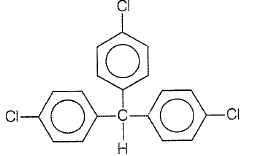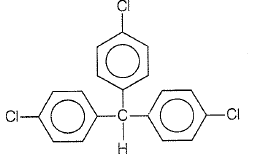Stephen's reaction is reduction of:
(1) alkyl cyanide with LiAlH4
(2) alkyl cyanide with SnCl2 and HCl
(3) alkyl isocyanide with Na and alcohol
(4) acyl halide in the presence of Pd/BaSO4
स्टीफन अभिक्रिया में अपचयन है:
1. LiAlH4 के साथ एल्किल साइनाइड
2. SnCl2 और HCl के साथ एल्किल साइनाइड
3. Na और एल्कोहॉल के साथ एल्किल आइसोसाइनाइड
4. Pd/BaSO4 की उपस्थिति में एसिल हैलाइड
The identical C-O bond lengths in carboxylate ions are due to:
(1) resonance
(2) presence of carbonyl group
(3) presence of alkyl group
(4) none of the above
कार्बोक्सिलेट आयनों में समान C-O बंध की लंबाई निम्न के कारण होती है:
1. अनुनाद
2. कार्बोनिल समूह की उपस्थिति
3. एल्किल समूह की उपस्थिति
4. उपरोक्त में से कोई नहीं
Trichloroacetaldehyde, CCl3CHO reacts with chlorobenzene in the presence of sulphuric acid and produces
1. 
2. 
3. 
4. 
ट्राइक्लोरोऐसीटैल्डिहाइड, CCl3CHO सल्फ्यूरिक अम्ल की उपस्थिति में क्लोरोबेंजीन के साथ अभिक्रिया करता है और उत्पादित करता है-
1. 
2. 
3. 
4. 
Acetone is used in:
(1) face creams
(2) vanilla
(3) nail polishes
(4) sweet smelling erasers
एसीटोन का उपयोग किया जाता है:
1. चेहरे पर लगाने वाली क्रीम में
2. वैनिला में
3. नाख़ून पॉलिश में
4. मीठी गंध वाली रबर में
Alkaline hydrolysis of R2C.Cl2 forms:
(1) propanone
(2) propane
(3) alkanone
(4) alkanal
R2C.Cl2 का क्षारीय जलअपघटन निर्मित करता है:
1. प्रोपेनोन
2. प्रोपेन
3. एल्केनोन
4. एल्केनल
Jone's reagent is:
(1) acidified KMnO4
(2) K2Cr2O7 + H2SO4 or chromic acid + H2SO4
(3) alkaline K2Cr2O7
(4) none of the above
जोन्स अभिकर्मक है:
1. अम्लीकृत KMnO4
2. K2Cr2O7 + H2SO4 या क्रोमिक अम्ल + H2SO4
3. क्षारीय K2Cr2O7
4. उपरोक्त में से कोई नहीं
Both acetaldehyde and ketone react with:
(1) ammoniacal AgNO3
(2) rochelle salt
(3) 2,4-dinitro phenylhydrazine
(4) all of the above
एसीटैल्डिहाइड और कीटोन दोनों किसके साथ अभिक्रिया करते हैं?
1. अमोनियामय AgNO3
2. रोशेल लवण
3. 2,4-डाइनाइट्रो फेनिलहाइड्राजीन
4. उपरोक्त सभी
Among the given compounds, the most susceptible to nucleophile attack at the carbonyl group is:
(1) MeCOCl
(2) MeCHO
(3) MeCOOMe
(4) MeCOOCOMe
दिए गए यौगिकों में, कार्बोनिल समूह में नाभिकरागी आक्रमण के लिए सबसे अतिसंवेदनशील है:
(1) MeCOCl
(2) MeCHO
(3) MeCOOMe
(4) MeCOOCOMe
For the reaction:
Which reagent will be appropriate for the above conversion?
1. Zn-Hg/HCl
2. NH2-NH2/OH-
3. LiAlH4/H
4. HI/P
अभिक्रिया 
उपरोक्त रूपांतरण के लिए कौन सा अभिकर्मक उपयुक्त होगा?
1. Zn-Hg/HCl
2. NH2-NH2/OH-
3. LiAlH4/H
4. HI/P












